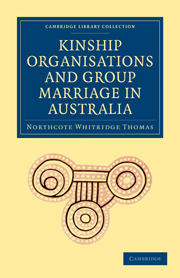Book contents
- Frontmatter
- PREFACE
- Contents
- BIBLIOGRAPHY
- INDEX TO ABBREVIATIONS
- CHAPTER I INTRODUCTORY
- CHAPTER II DESCENT
- CHAPTER III DEFINITIONS AND HISTORY
- CHAPTER IV TABLES OF CLASSES, PHRATRIES, ETC.
- CHAPTER V PHRATRY NAMES
- CHAPTER VI ORIGIN OF PHRATRIES
- CHAPTER VII CLASS NAMES
- CHAPTER VIII THEORIES OF THE ORIGIN OF CLASSES
- CHAPTER IX KINSHIP TERMS
- CHAPTER X TYPES OF SEXUAL UNIONS
- CHAPTER XI GROUP MARRIAGE AND MORGAN'S THEORIES
- CHAPTER XII GROUP MARRIAGE AND THE TERMS OF RELATIONSHIP
- CHAPTER XIII PIRRAURU
- CHAPTER XIV TEMPORARY UNIONS
- APPENDIX: ANOMALOUS MARRIAGES
- INDEX OF PHRATRY, BLOOD, AND CLASS NAMES
- INDEX OF SUBJECTS
- Plate section
CHAPTER IX - KINSHIP TERMS
Published online by Cambridge University Press: 05 February 2012
- Frontmatter
- PREFACE
- Contents
- BIBLIOGRAPHY
- INDEX TO ABBREVIATIONS
- CHAPTER I INTRODUCTORY
- CHAPTER II DESCENT
- CHAPTER III DEFINITIONS AND HISTORY
- CHAPTER IV TABLES OF CLASSES, PHRATRIES, ETC.
- CHAPTER V PHRATRY NAMES
- CHAPTER VI ORIGIN OF PHRATRIES
- CHAPTER VII CLASS NAMES
- CHAPTER VIII THEORIES OF THE ORIGIN OF CLASSES
- CHAPTER IX KINSHIP TERMS
- CHAPTER X TYPES OF SEXUAL UNIONS
- CHAPTER XI GROUP MARRIAGE AND MORGAN'S THEORIES
- CHAPTER XII GROUP MARRIAGE AND THE TERMS OF RELATIONSHIP
- CHAPTER XIII PIRRAURU
- CHAPTER XIV TEMPORARY UNIONS
- APPENDIX: ANOMALOUS MARRIAGES
- INDEX OF PHRATRY, BLOOD, AND CLASS NAMES
- INDEX OF SUBJECTS
- Plate section
Summary
Some classless two-phratry tribes observe in practice the same rules as the four and eight class tribes when they are deciding what marriages are permissible. The Dieri and Narrangga follow the eight-class rule; the position of the Urabunna is somewhat uncertain owing to the obscurity of our authorities, which again is probably due to their lack of intimate acquaintance with the tribe; and the Wolgal, Ngarrego and Murring have the simple four-class rule that a man marries his mother's brother's daughter.
We have seen in an earlier chapter that kinship and consanguinity are distinct in their nature, though among civilised peoples they are not in practice distinguishable. In the lower stages of culture it is otherwise, as will be shown in detail below. Corresponding to this distinction of consanguinity and kinship but not parallel to it we have two ways of expressing these relationships—the descriptive and the classificatory. The terminology of the former system is based on the principle of reckoning the relationship of two people by the total number of steps between them and the nearest lineal ancestor of both. The latter does not concern itself with descent at all but expresses the status of the individual as a member of a group of persons.
- Type
- Chapter
- Information
- Kinship Organisations and Group Marriage in Australia , pp. 93 - 101Publisher: Cambridge University PressPrint publication year: 2010First published in: 1906

